
I planned to write this article back in the spring of 2020, but I constantly put it in the back box. I would like to say that the reason for this is the "ecological" situation in the country and the world, but in reality - the desire to accumulate more practical and test material and, what can you do, unlimited procrastination. Now, when the marketing department writes to me more often than creditors, and, apparently, will soon begin to come home to inquire about their well-being, I decided that there was nowhere else to save. Moreover, there is enough experience, and AMD has released processors based on the new Zen 3 architecture.
Initially, the article wanted to "bump heads" two manufacturers - AMD and Intel. But all the dates were missed. Therefore, instead of explicitly comparing “red” and “blue”, we will test two generations of Ryzen - on Zen 2 and Zen 3. In fairness, we will not forget about Intel. Moreover, historically we have always offered servers on their processors - both server and desktop. And articles with tests were released exclusively about them. Intel's monopoly in the lineup of configurations we presented ended about a year ago - in December 2019 we began to offer servers based on AMD Ryzen 7 3700X and AMD Ryzen 9 3900X, then in October 2020 AMD Ryzen 9 3950X was added to them, and in December 2020 and AMD Ryzen 9 5900X.
In general, I decided that the processors of both manufacturers on the test bench may not be quite on time, but definitely not bad.
From the history of my acquaintance with AMD
Before we get to tests and graphs, I would like to move a little off the main topic. If you are not a supporter of nostalgia, you can safely skip this part. In addition to the author's memories of my bygone youth and my experience of working with computers, including AMD processors, there will be nothing here.
For me, acquaintance with AMD products began back in 2006, when, as a first year student, I got a job as an apprentice in a service center and began to “repair computers”. Then in my "personal use" was a home computer based on an Intel Pentium 4 531 processor at 3 GHz, already with Hyper-Threading. On a proprietary Intel motherboard with SATA1, an 80GB SATA hard drive from Seagate and an ATI Radeon X300 graphics card. At that time, not the most top-end, but still a terribly cool computer among classmates, which made it possible to calmly play on the grid in CS 1.6.
Working in the service, I first saw computers and laptops on AMD processors (Athlon, Duron and Turion) - in my subjective opinion, there were about 50/50 of them in the city with Intel machines. In addition, there were x86-compatible processors VIA and Cyrix from time to time. Around the same time, a legend appeared that AMD is heating up and even burning out from overheating, which was, in general, not far from the truth . By the way, this fact allowed Intel to successfully pass "under the radar" of the consumer with all the heap of technical and marketing mistakes that were observed during the transition from Pentium 4 to Core 2 Duo.
Using my official position, I quickly assembled a personal computer based on an Intel Core 2 Duo E7200 processor on an LGA775 socket and an Asus motherboard - as I saw dozens of Gigabyte motherboards on socket 478 with burnout in the south bridge. Everything suited me, except that the processor did not have support for hardware virtualization and the VirtualBox that appeared then worked very slowly. I upgraded to an AMD Athlon II X2 and, thanks to forward and backward socket compatibility, had a great opportunity to upgrade quietly for a couple of years. Intel could not boast of this.
Later I switched to AMD Phenom II X6 and it was incredible! Gentoo Linux, which was my main OS back then, took less than a day to compile! None of my colleagues on Intel Core 2 Quad could get such a result. Until a certain point, I believed that this was the apotheosis of computer thought. So far, the vendor has not offered new AMD FX-8100 based on Bulldozer microarchitecture. Eight cores, not some pitiful six! And I was updated ... The speed of "rebuilding the world" dropped, and I learned that the processor can overheat on "boxed" cooling. Later I updated a couple of times - FX-8150, FX-8300 - and settled on AMD FX-8350 on the Piledriver microarchitecture, and with the motherboard update (socket AM3 +). But it was still not the same. Therefore, in my memory, the Phenom II X6 line has remained AMD's best for many years.
Time passed, youthful acne faded away, Gentoo Linux pushed Fedora Linux, and the need for daily compilation disappeared. I came to terms with the past, started a family, and, as a result, lost the opportunity to constantly upgrade my personal equipment. AMD watched the release of new lines without much enthusiasm, and then completely moved to Apple products, ended his career as a serviceman and local host administrator and lost contact with desktops. “History has become a legend, a legend a farce. And then they made up anecdotes ”.
And in 2018 AMD releases a new generation of processors based on the Zen architecture. I was all revived: something new after so many years of stagnation. Even then, I worked here, where I work, and as I wrote above, I only dealt with Intel processors. However, hoping that one day we will offer configurations based on AMD.
And now my ghostly hope suddenly becomes a reality. Not without my participation, of course.
Remembering the story of the FX-8100, it was decided to start with the Reisens of the third thousand, whose tests showed, in my opinion, simply gorgeous results. And now a new line of processors based on the Zen 3 architecture has come out, which also has not been spared the fate of being tested.
So, dear reader, discard subjectivism and skepticism. Because, despite all my genuine love for processor products from AMD, which after many years of technical idleness begins to win the market almost from scratch, I am for an objective approach - the test results will say everything for me.
A few words about the process technology and nanometers
Many, including us, have repeatedly complained that Intel has long been stuck at its 14 nm. The proof of this was the frequent conversations like: “And AMD has 7 nm for a long time. And soon there will be even less ... ". I decided to dig into the issue a little, so here is my brief remark on the technical process and the effect of the declared nanometers on the processor performance.
An important characteristic for comparing technical processes is still the number of transistors per square millimeter. That is, how many simplest logical elements are in the processor crystal. The fact is that the technical process does not speak about the size of the transistor itself, but about the size of one of its parts - namely, the gate (as far as I can imagine). The rest of the constituent elements of the transistor are not strictly tied to the size of the technical process.
Earlier, in my opinion, before the appearance of such a technology as FinFET, in which three-dimensional rather than planar transistors were used, it still made sense to compare the manufacturing processes of manufacturers, starting from the size of the transistor. But then the manufacturers went in different directions, developing their own technological solutions. And "nanometers" from a real indicator turned into an abstract one. At the same time, the habit of comparing technical processes has not gone anywhere, although it all boiled down to comparing "soft to warm". Now, focusing on the size of the declared technical process is not so much pointless as not very indicative. And it is worth comparing completely different parameters.
For example, in this article, the author gives an interesting table comparing technical processes:

Sourcewww.hardwareluxx.ru
- Fin Pitch: ( )
- Min Metal Pitch:
- Fin Height: Si
- Fin Width:
There is also a distance between the transistors on the substrate. And, it should be noted that it differs for manufacturers such as Samsung, TSMC, Intel and GF, with the same declared size of the technical process.
As a result, it turns out that the concept of technical process at one point became purely marketing and does not speak, as in the old days, about the technical advantage of processors, which have less. Thus, the TSMC 7nm FinFET process technology, on which the two latest generations of AMD processors are manufactured, cannot be called the best relative to Intel's proprietary 14 nm process technology. If you want to delve deeper into the topic, then here is one interesting article and an educational video for you.on this occasion. And we are finally moving on to testing.
Testing
In the comments to the previous article, we were reasonably reproached for using different versions of benchmarks, which is reflected in the test results. What can I say. It often happens that the "cartridges" have just been brought up, and they have already run out. In the sense that it is far from always possible to re-test for specific processors on the current versions of benchmarks. But this time I still managed to get my hands on a full ammunition load, so then you can see not only the results of testing Geekbench of the fourth version, but also the fifth.
And since we started talking about what affects the test results, I remembered one example from life. Once a meteorologist was asked in an interview “Tell me what affects the weather forecast?” He replied - it's easier to say that it doesn't. So the phase of the moon does not affect the test results, but this is not accurate.
But seriously, there are more than enough factors that can affect the final test result. And it's not just an operating system or a Linux distribution. The result will also depend on the OS kernel version, system software versions, memory sticks, even if they have the same characteristics, chipset, processor power and cooling phases, BIOS version, benchmark version, especially the phoronix package, whose tests are updated more often than presentations Apple in 2020. Even the drive affects, for example, the passing of the phoronix Apache test. In general, there are a lot of conditions that are difficult to repeat over time. Therefore, to the best of our ability during testing, we try to create as much as possible the same conditions for those processors, the results of which will be included in one article.
I would especially like to note the following point. It refers to a lesser extent to Intel processors, which have been making refreshes of the same architecture for many years, and to a greater extent to AMD processors: after the release of processors, the first test results are worse than the results of the same tests a year later. I guess this is due to the addition of support for the corresponding processors and optimizations in the kernel, software and benchmarks. That is why the results of the first tests of AMD processors did not get here: they were good, but the new ones are even better.
This time we double-checked everything so that the reader can get the most up-to-date test results.
So, "what got into our tenacious paws today?"
First, these are two AMD processors based on Zen 2 architecture - Ryzen 9 3900Xand Ryzen 9 3950X . It would be more honest to compare them with the ninth thousand Intel processors - Core i9-9900K. Almost "the same age" after all. But we decided that another representative from Intel would take part in the comparison, or rather the Core i9-10900K , a relatively top processor for the LGA1200 socket. On the one hand, we already have comparative tests of i9-9900K and i9-10900K , on the other hand, both of these processors are built on the same architecture. So everything is fair.
We also decided to test the fresh AMD 5,000 - platforms based on them have recently added to our server line, so traditional tests are indispensable. We will check three processors on the Zen 3 architecture: Ryzen 7 5800X, Ryzen 9 5900X, Ryzen 9 5950X .
Note that we are not just comparing processors from the same manufacturer in the form of refreshes, as we did earlier. This time we have the opportunity, firstly, to compare processors from two different manufacturers, and secondly, processors from one manufacturer on two different architectures.
In the case of comparing Intel and AMD, EVERYTHING is different: manufacturer, nuclear architecture, process technology, processor cache, both in volume and in execution architecture, quantitative and qualitative solution of core execution, processor frequency, number of computing units. The only thing that unites these processors is the x86 / x86_64 architecture... And that is technically not entirely true. In the case of comparing AMD processors of different generations: these are two different core architectures. Well, and, perhaps, we will now combine them with our tests.
It is worth saying a few words about the third and fifth thousand AMD processors. According to the company, it has managed to make an even bigger leap in performance with the Zen 3 line than with previous generations of Ryzen. Thanks to this, the new items, according to the manufacturer, should become the fastest solutions on the market, not only in computing tasks, but also in games. AMD claims that it has seriously redesigned the crystal architecture, which made it possible, without increasing the base frequencies on the same technical process, to raise the overall performance to 19% relative to Zen 2. Well, we'll see.
So, six processors are involved in testing:
- Intel Core i9-10900K,
- AMD Ryzen 9 3900X,
- AMD Ryzen 9 3950X,
- AMD Ryzen 7 5800X,
- AMD Ryzen 9 5900X,
- AMD Ryzen 9 5950X.
Only single-unit servers (1U) were used in testing. All processors are cooled by liquid cooling (hereinafter referred to as "water cooling", CBO, "water", "dropsy").
AMD processors are water cooled in a classic design for 1U platforms. The Intel processor is cooled by advanced liquid cooling - a customized solution of our own production, the configuration of which we still do not cover. Otherwise the i9-10900K will overheat. Well, at least they don't burn.
All test samples are brought under a single common denominator: 1U, "water", the same RAM at a frequency of 2933, the same data storage. Memory with a frequency of 2933 is the maximum for i9-10900K, while the presented "Ryazan" support memory for 3200. And as you know, the performance of AMD processors, including in tests, strongly depends on the memory frequency. From our side, this is done in order, so to speak, to equalize the chances.
AMD processors are tested on the same motherboard with the new chipset.
And one more point that I would like to draw your attention to.
Comparison of processors AMD 9 3900X, AMD 9 3950X and AMD 9 5900X, AMD 9 5950X is logical and understandable: the last successors of the previous ones. But AMD 7 5800X stands out from this row. The fact is that our tariff line also includes AMD 7 3700X, which I would love to compare with the new AMD 7 5800X. And that would also be understandable. Alas, there was no opportunity to test it at the time of preparation of the article. But since there are 5800X results, why not share them.

Platforms performance characteristics
Intel i9-10900k processors
- Motherboard: ASRockRack W480D4U
- RAM: 32GB DDR4-2933 MT / s Kingston 2 pieces
- NVMe SSD: 1TB Intel 665P
AMD processors
- Motherboard: ASRockRack X570D4U (bios beta)
- RAM: 32GB DDR4-2933 MT / s Kingston 2 pieces
- NVMe SSD: 1TB Intel 665P
Software part: OS CentOS Linux 8 x86_64 (8.3.2011).
Kernel: 4.18.0-240.1.1.el8_3.x86_64
Introduced optimizations relative to standard installation: added kernel launch options elevator = noop selinux = 0
Testing is performed with all Specter, Meltdown and Foreshadow patches backported to this kernel.
List of tests that were carried out:
1) Sysbench
2) Geekbench 4
3) Geekbench 5
4) Phoronix Test Suite
Detailed description of tests
Geekbench
, . . :
: «». «», .
Sysbench
Sysbench — ( ) : , , . , . : CPU speed events per second — . , .
Phoronix Test Suite
Phoronix Test Suite — . — . : Himeno LAME MP3 Encoding.
, .
, — .
, . . :
- Single-Core Score — .
- Multi-Core Score — .
: «». «», .
Sysbench
Sysbench — ( ) : , , . , . : CPU speed events per second — . , .
Phoronix Test Suite
Phoronix Test Suite — . — . : Himeno LAME MP3 Encoding.
, .
- John the Ripper . Blowfish. .
- Himeno — , .
- 7-Zip Compression — 7-Zip p7zip .
- OpenSSL — , SSL (Secure Sockets Layer) TLS (Transport Layer Security). RSA 4096- OpenSSL.
- Apache Benchmark — , 1 000 000 , 100 .
, — .
- C-Ray CPU . (16 ), 8 1600x1200. .
- . LAME MP3 Encoding . .
- . ffmpeg x264 — . .
Test results

5950X is better than 3950X - 160%.
5900X is better than 3900X by 166%.

5950X is better than 3950X - 23.3%.
5900X is better than 3900X - 20.7%.
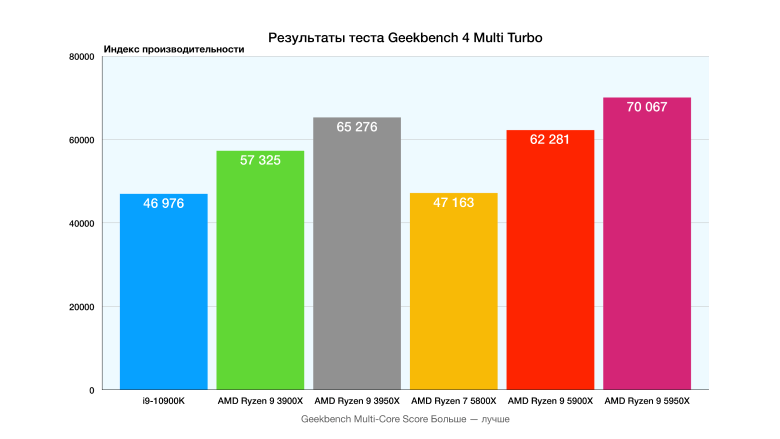
5950X is better than 3950X - 7.3%.
5900X is better than 3900X —8.7%.

5950X is better than 3950X —27.2%.
5900X is better than 3900X - 25.8%.

5950X is better than 3950X - 8.5%.
5900X is better than 3900X —10.8%.

5950X loses to 3950X - 1.1%.
5900X is better than 3900X - 0.2% (almost equal).
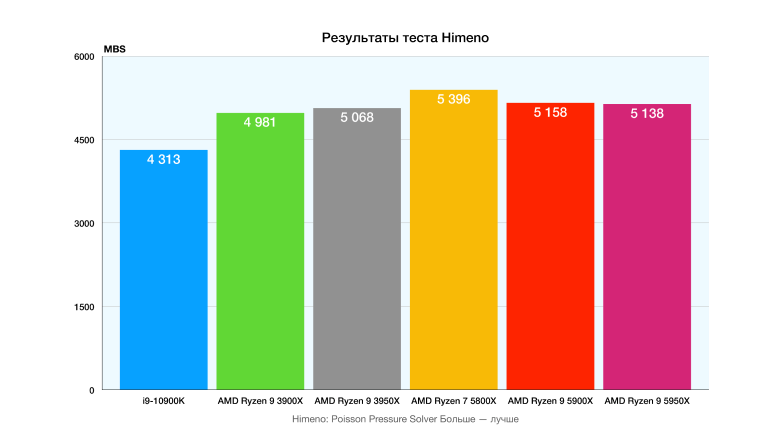
5950X is better than 3950X - 1.4%.
5900X is better than 3900X - 3.6%.
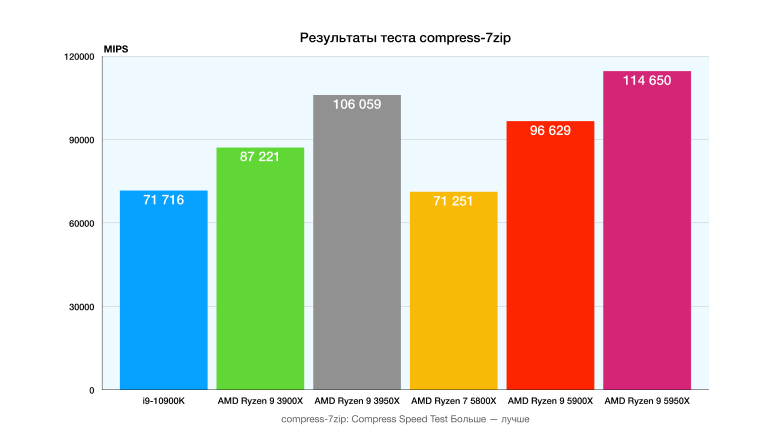
5950X is better than 3950X - 8.1%.
5900X is better than 3900X - 10.8%.
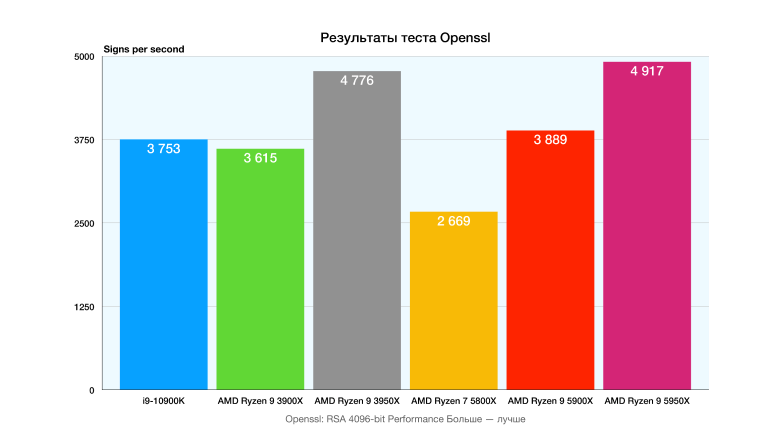
5950X is better than 3950X - 3.0%.
5900X is better than 3900X - 7.6%.
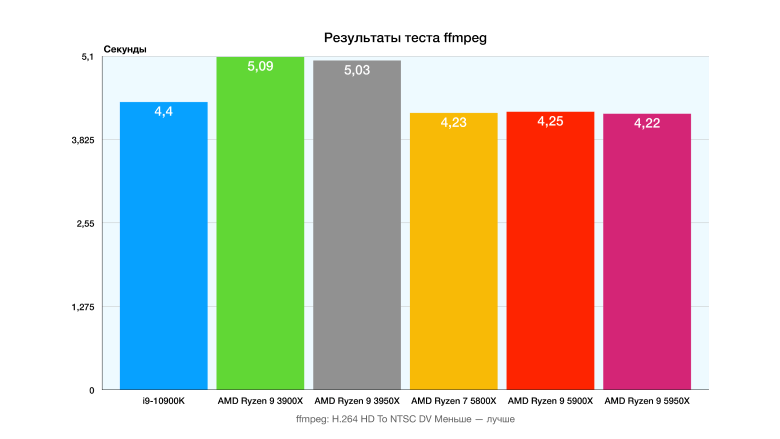
5950X is better than 3950X - 16.1%.
5900X is better than 3900X - 16.5%.

5950X is better than 3950X - 17.3%.
5900X is better than 3900X - 20.3%.
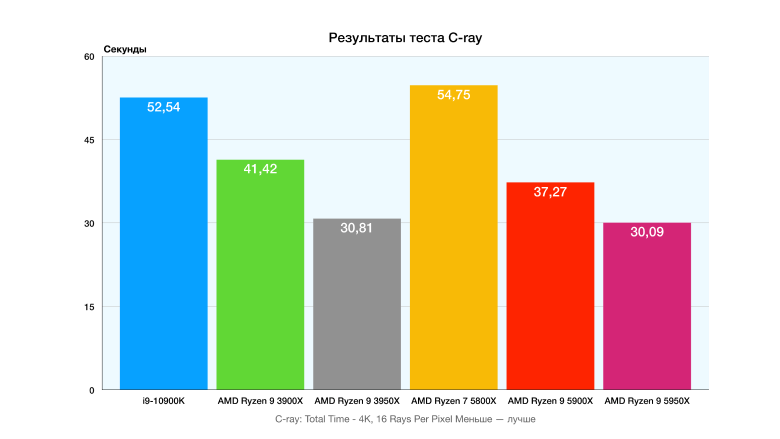
5950X is better than 3950X - 2.3%.
5900X is better than 3900X - 10.0%.

5950X is better than 3950X - 21.7%.
5900X is better than 3900X - 19.8%.

In general, the results were predictable - the latest generation of AMD 5,000 confidently bypasses its predecessors and leaves the relatively fresh Intel Core i9-10900K far behind. It should be noted that the Ryzen 9 3950X from the "third thousand" showed itself very worthy - according to Geekbench tests, it ranks second after new products, and in the John the Ripper multi-threaded test, which measures the number of operations per second, it even surpassed the Ryzen 9 5950X ...
The Ryzen 7 5800X also proved to be quite interesting, becoming the leader not only in the Geekbench tests in both single-threaded and multi-threaded modes, but also in other tests - for encoding audio data (encode mp3) and the number of requests per second (Apache) ... I would recommend to take a closer look at servers with this processor. Especially for processing media content or as a web server.
Well, since we promised a comparison with Intel, I will say a few words about them as well. Judging by the test results, the i9-10900K has a chance to compete for the championship in single-threaded Geekbench tests (most likely, thanks to a couple of additional GHz), but only with AMD “third thousand” - the indicators of “fifth thousand” are much better. And even the “third thousand” makes the i9-10900K in most tests.
Since the "party secretariat" hinted to me that loud jubilation is not in our style, I will simply calmly express my opinion. In my opinion, Intel for two years now, if not catching up, then at least on a par with AMD in the desktop and gaming segments. As soon as Intel releases a new generation of processors, AMD immediately "beats this card". Apparently, the superiority of "blue" over "red" is coming to an end. "Red", in my opinion, like Phoenix - burned out when the FX series was released, and reborn from the ashes with the release of Ryzen.
As you can see, my genuine love for AMD is caused not only by romantic feelings, but also by banal cold calculation. If you're following the news, AMD had a 50.8% share of the world's desktop processor market in early 2021, according to data from PassMark Software. Intel's share, accordingly, fell to 49.2%. This means that the competition between the giant manufacturers is reaching a different level, which will keep both companies in good shape. Therefore, I assume that 2021 will be no less dynamic than the past 2020 in terms of breakthrough news on the processor market. Moreover, both companies have something to improve - Intel still has to deal with the 10 nm process technology, and AMD, at least, will solve supply problems so that it does not work out the way it did in December, when not everyone received what they ordered.
The tests used servers based on AMD Ryzen and Intel Core processors from 1dedic.ru . Dedicated servers with these processors can be assembled in the configurator and ordered with a 7% discount for the selected payment period - 1, 3, 6 or 12 months using the HABR1DEDIC21 promo code . The discount does not apply to additional services connected to the server. The promo code is valid until February 28, 2021.